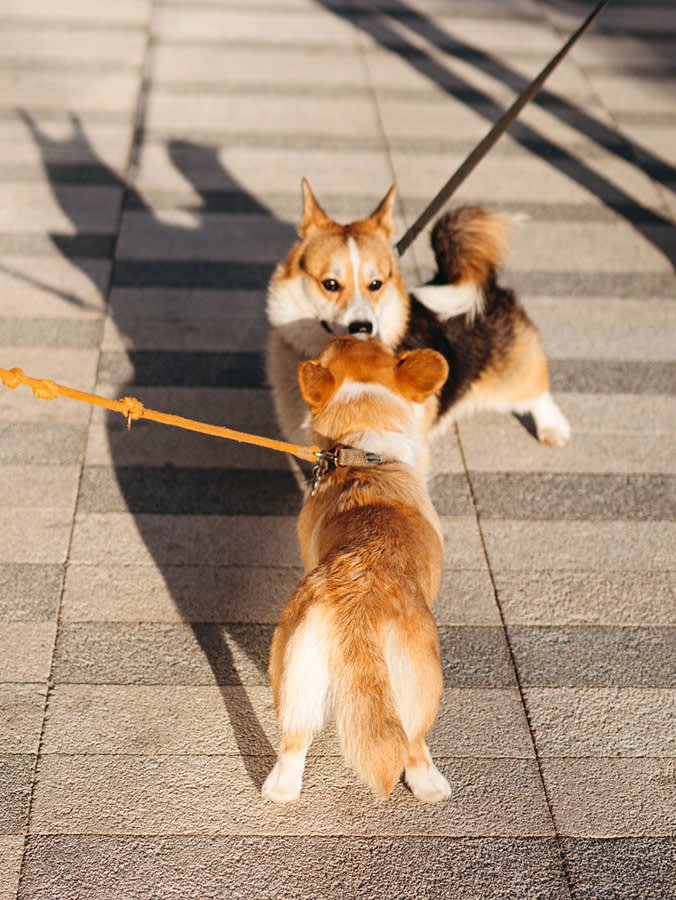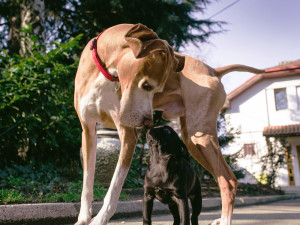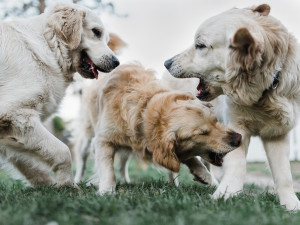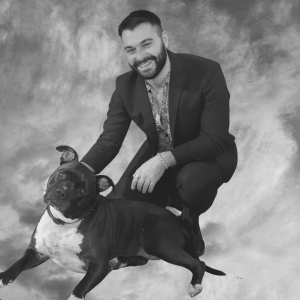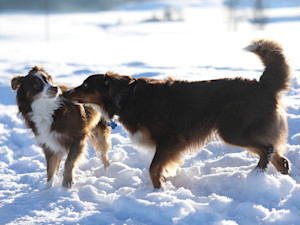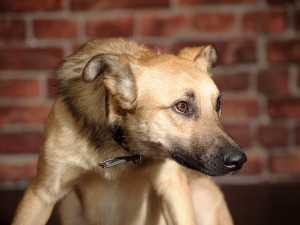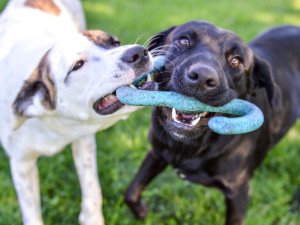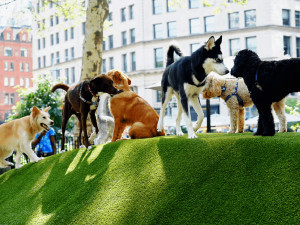Seriously, Your Dog Does Not Want to Meet Another Dog On-Leash
Trainer Charlie DiBono warns against these greetings on all fronts.
As someone prone to verbal blunders, I’m intimately familiar with the concept of an awkward introduction. But rather than just general weirdness after nervously saying the exact wrong thing, ill-advised greetings can have serious lingering effects on dogs. This is especially true for one of the most common meeting setups — face-to-face on leash.
“I strongly suggest people don’t have on-leash greetings,” warns Charlie DiBono, trainer and founder of Body and Mind K9opens in new tab in Long Beach, California. He explains that leashes are one of the best tools for communicating with our dogs, and when we introduce them to other pets while on one, it can jeopardize that connection. Not to mention, devaluing any obedience training they’ve had. This is because when our pup sees another dog, and we allow them to meet, we tend to tighten the leash. But that translates to the dog that we are nervous and, therefore, they should be, too. This communication can result in increased anxiety or a fight, which is the likely outcome.
Trick question: All dogs are perfect! But find out which type is the best fit for you.
The Problem With On-Leash Greetings
“When meeting on-leash, dogs are coming at each other head-on. In the dog world, this means ‘I am a threat.’ It is natural for the dogs to feel defensive and react accordingly,” DiBono says. Even if an interaction is entirely positive on the surface and both dogs are cordial and calm, it can still cause problems almost immediately. After a lovely meet-and-greet, your pup will now want to say hello to every other dog they see. And if you don’t oblige, they may get frustrated and resort to leash reactivity or pulling.
The impetus of these risks for dogs on leashes is the same reason I stay off Tinder — it’s an unnatural way of meeting. “Dogs naturally greet each other by sniffing each other’s rear ends and circling around each other. They typically approach in an arc rather than a straight line in an effort to show they are not a threat. This behavior is difficult to replicate while on a leash and the tension from the leash can cause reactivity in dogs, leading to aggression or fear,” DiBono explains.
How much do you spend on your pet per year?
How On-Leash Greetings Affect Your Dog in the Long-Term
There are far-reaching, lingering effects of putting dogs in these types of situations. Not only will your dog potentially develop anxiety about going outside and seeing other dogs or leash-reactivity issues, but they may also lose trust in you. This can diminish your authority in communication and make training much more difficult. DiBono adds: “When the relationship between the owner and dog becomes untrustworthy, the dog begins to think they can ignore their owner and always run up to other dogs or that they can’t trust the owner to protect their boundaries.”
DiBono explains that the ideal scenario for two dogs to meet is in a neutral and controlled environment with both animals off-leash. This can be a fenced-in yard or any enclosed space. Inviting a professional trainer to oversee the introduction, especially if the pets are unfamiliar with each other, would also be immensely helpful. Additionally, avoiding places with high stimuli, like busy parks or crowded streets, will help minimize adverse reactions. It’s also good to schedule the meetup around a time that is not mealtime or near favorite toys that dogs may feel protective over.
How to Make Your On-Leash Greeting Less Risky
If you must introduce your dog on a leash, there is a way to limit the negative consequences. DiBono recommends first walking with both dogs parallel to one another, allowing one to fall behind and sniff the other, then vice versa. After a hopefully encouraging initial meeting, he suggests going to a large enclosed space. You can then drop your leash, but DiBonos adds to not remove the leash from the dog’s collar in the event that you must intervene.
More than anything, if you’re out on a walk understand that you have no obligation to anyone or anyone’s dog except your own. “I would avoid all strange dogs,” DiBono says. “Your dog has no need to say hello and both dogs will be safer for it. If you take your dog in public, often it’s up to you to advocate for them and not allow others to rush them. Stick to dogs whose temperament and owners you are familiar with.”
